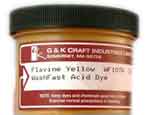Chenille yarn - is it rayon, nylon, or what?
Name: Karen
—ADVERTISEMENT—
Washfast Acid dyes
at Paradise Fibers

Washfast Acid dyes
Excellent for use on wool and nylon. One ounce of dye will dye six pounds of fiber!
at Paradise Fibers

Washfast Acid dyes
Excellent for use on wool and nylon. One ounce of dye will dye six pounds of fiber!
Set direct or all-purpose dye with Retayne
Country or region: USA
Message: I have a question about dyeing chenille yarn. I recently acquired some chenille machine yarn. I was not sure what the fiber was and just out of curiousity threw it in when I was dyeing some wool. It turned out that the color took really well and did not appear to bleed. When I took the yarn to my local yarn shop, the owner thought that it was rayon chenille. From what I have read every where, food color is not supposed to dye rayon. I have since dyed multiple skeins of the chenille with food color. I have had great success but just recently had a skein that is bleeding.
So my question is this - is it possible that this is rayon? Could I dye rayon with food color and not have it bleed? If it is rayon, is there any way to make certain that it will not bleed if I continue this process - is the degree of heat or acidity necessary significantly different for rayon vs. wool. The other thought I had with this is that it was a problem with red dye. I seem to have more issues with red bleeding (in wool) than any other color.
Your thoughts on this would be most appreciated.
My first thought is that your chenille yarn might be made of nylon. Although it is synthetic, nylon, like wool, is a polyamide, and it dyes very well with acid dyes, especially in the presence of a mild acid such as you use in dyeing wool. (See "About Acid Dyes" and "How to dye nylon".)
The best thing to do to identify your fiber now would be to try a burn test of a small test piece of yarn, taking care to do so safely. Different fibers produce different odors and different ashes when burned. Rayon is a form of cellulose, so it smells like burning paper. Wool smells like burning hair. Nylon melts instead of burning well, and it smells like celery or burning plastic. Take a look at Griffin Dyeworks' Burn Test page, and Ditzy Prints' Fiber Burn Chart, for instructions and for help in interpreting your results.
There are some acid dyes which can also color cellulose fibers, such as rayon; when they do so, they are acting as direct dyes. (See "About Direct Dyes".) Direct dyes are not as washfast on rayon as another type of dye, known as fiber reactive dye, but their washfastness can be improved by the use of a commercial dye fixative, such as Retayne. (Vinegar and salt do not work for this.) It's possible that you have rayon chenille and that you just happened to be using an acid dye that works pretty well as a direct dye. However, food coloring performs quite poorly on rayon and other plant fibers. (See "Using Food Coloring as a Textile Dye for Protein Fibers".)
If you find that you do have a rayon yarn to dye, I strongly recommend you obtain a fiber reactive dye, such as Procion MX, or Drimarene K, or Sabracron F (also known as Novacron F). The results are much more washfast than other types of dye on cellulose. (See "About Fiber Reactive Dyes".)
Red food coloring is widely known for bleeding badly when it is used as a textile dye. The two red dyes that are used as food colorings, allura red and erythrosine, were chosen for their relative safety when eaten, not for their ability to work well on yarn. You will get much better results if you use a high quality acid dye, instead of food coloring. Food coloring is fun to use on wool and nylon, and it has great advantages for working with children, or for using your good cooking pots to dye in (which you should never do with dyes other than food colorings), but you can't expect it to be the best dye for yarn.
For better results than you can get from food coloring, I recommend other acid dyes, such as the acid dye Polar Red, and another acid dye, WashFast Acid Magenta. These dyes work very well on both wool and nylon. The most popular dyes for hand dyers in the US are the Lanaset dyes, which are extremely resistant to fading, even if washed in hot water, and the WashFast Acid dyes. Be sure to find a good recipe for your specific dye type, as the best conditions for dyeing vary somewhat from one type of dye to another.
(Please help support this web site. Thank you.)
Posted: Thursday - May 13, 2010 at 03:14 PM
Follow this blog on twitter here.
Quick Links
- All About Dyes & Dyeing Top -
- Top of this blog -
- FAQ -
- The Dye Forum -
- How to Tie Dye - How to Batik -
- Books - Toys - Plants -
- Top of this blog -
- FAQ -
- The Dye Forum -
- How to Tie Dye - How to Batik -
- Books - Toys - Plants -
More in this category:
- -
Statistics
Total entries in this blog:
Total entries in this category:
Published On: Aug 29, 2012 02:48 PM
Total entries in this category:
Published On: Aug 29, 2012 02:48 PM